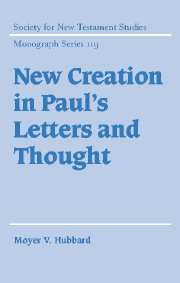Book contents
- Frontmatter
- Contents
- Acknowledgments
- List of abbreviations
- 1 Introduction: the current debate
- PART I NEW CREATION: CENTRAL JEWISH TEXTS
- 2 New creation in the Jewish Scriptures: an overview
- 3 New creation in apocalyptic Judaism: Jubilees
- 4 New creation in Diaspora Judaism: Joseph and Aseneth
- Part II FROM DEATH TO LIFE: NEW CREATION IN THE CONTOURS OF PAUL'S THOUGHT
- Part III THE OLD AND THE NEW: NEW CREATION IN THE CONTEXT OF PAUL'S LETTERS
- References
- Index of passages cited
- Index of modern authors
3 - New creation in apocalyptic Judaism: Jubilees
Published online by Cambridge University Press: 02 December 2009
- Frontmatter
- Contents
- Acknowledgments
- List of abbreviations
- 1 Introduction: the current debate
- PART I NEW CREATION: CENTRAL JEWISH TEXTS
- 2 New creation in the Jewish Scriptures: an overview
- 3 New creation in apocalyptic Judaism: Jubilees
- 4 New creation in Diaspora Judaism: Joseph and Aseneth
- Part II FROM DEATH TO LIFE: NEW CREATION IN THE CONTOURS OF PAUL'S THOUGHT
- Part III THE OLD AND THE NEW: NEW CREATION IN THE CONTEXT OF PAUL'S LETTERS
- References
- Index of passages cited
- Index of modern authors
Summary
From the table in the corner they could see a world reborn.
Les MisérablesJubilees: a case study
As “one of the most important documents in the history of the Jewish religion”, the book of Jubilees provides an immensely valuable introduction to the issues and ideas which shaped the “Judaism” of the pre-Christian era. Written either just prior to the Maccabean uprisings, or sometime early in the Maccabean era, Jubilees offers a commentary on the tumultuous events of this period from a perspective closely related to that of the Hasidim, those pious defenders of the lawwhorallied to the support of Mattathias and his sons against the encroachments of Hellenistic culture. Jubilees' use of Enochian material, along with its obvious importance to the sectaries at Qumran, attests to its broader relevance and influence and renders it an ideal specimen for examination. Moreover, its length and literary integrity permit a more confident evaluation of its themes, especially in comparison with the composite work of 1 Enoch. Finally, if any weight at all can be attached to the traditional connection made between the Hasidim of the Maccabean era and the Pharisees of the New Testament era, and if any book can claim to illuminate the perspective of the pre-Christian Paul, the Pharisee par excellence (Phil. 3.5; cf. Acts 23.6; 26.5), Jubilees is that book.
Using Jubilees as a representative work of apocalyptically oriented Judaism, the goal in this section will be to understand new creation within the argument of this book and, by implication, within the apocalypses more generally. Because the main interest is in the book of Jubilees, the burden of corroborating evidence from other sources will be borne by the footnotes.
- Type
- Chapter
- Information
- New Creation in Paul's Letters and Thought , pp. 26 - 53Publisher: Cambridge University PressPrint publication year: 2002



